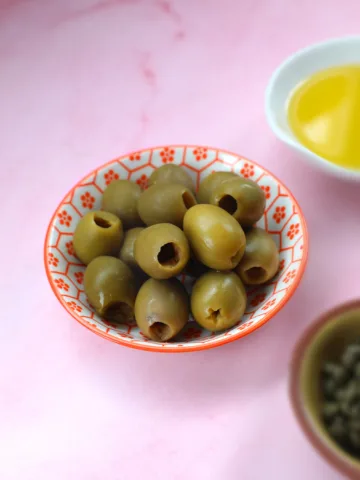Shallots are a great addition to dressings, sauces, and as an aromatic in savory dishes. But can you freeze shallots to store them long term? Or will that harm their taste and texture?

I love using fresh shallots to enrich flavors, especially in delicious recipes like green beans with bacon, seafood pasta, and stuffed pork loin. They provide a mild onion flavor with a hint of pleasant sweetness.
But what if you need to save some long term?
The good news is you can freeze shallots for up to 3 months. But it’s best not to freeze them whole.
Below, I’ll go over the best ways to keep shallots in the freezer, and I’ll cover the right way to thaw them out to preserve their flavor.
Jump to:
How to freeze shallots
The most effective way to freeze shallots is to chop or slice them first. Freezing whole shallots makes them hard to defrost, and therefore more difficult to chop cleanly when you’re ready to use them.

To freeze sliced or chopped shallots, follow these steps:
- Remove the peel. First wash and dry shallots, then simply take off the outer layer and discard.
- Chop or slice. Using a sharp knife, chop or slice the shallots into small pieces or to your desired size.
- Portion them out. It’s a good idea to freeze your shallots in different portions. That way they all won’t stick together during the freezing process and you’ll only need to defrost the amount you need.
- Place them in containers. Put your cut shallots in a single layer in freezer-safe plastic bags or an airtight container. The single layer will help keep them from clumping together and the container or bag will reduce exposure to excess air and prevent risk of freezer burn. You could also use ice cube trays.
- Add a date label.
Freezing shallots this way should make them last up to 3 months.
How to thaw shallots
The good news is that if you plan to use your frozen shallots in cooking, then you don’t need to thaw them out. You can simply add them as you’re making your dish and they’ll defrost on their own during the cooking process.
If you want to use raw shallots in a salad or salad dressing, for example, you’ll want to thaw them first. The best way to do it is to simply move them from your freezer to your fridge and let them gradually defrost. It may take a few hours depending on how big your portion is. This will help them keep their crunchy texture.
Avoid defrosting them in the microwave. While this will thaw them more quickly, it will harm their texture and you may end up with soggy or mushy shallots instead of crunchy ones.
Other ways how to store shallots
If you plan on your using shallots fairly soon after you get them, it’s best to store them whole in a cool, dry place with some air circulation like a pantry or dry cupboard, or a dark place like a cellar. They should keep for up to 2 months. If you notice any green shoots starting to sprout, simply remove them before using the shallots.
Wire mesh basket
An excellent option is to place shallots in a wire basket at room temperature on a kitchen counter, along with other aromatics like onions and garlic. The mesh lets air circulate around them to keep them dry, plus all of your aromatics are in one, easily accessible place.

Hanging basket or mesh bag
A hanging basket or mesh bag can be another great way to store shallots. This will allow air to circulate around them, and it keeps them away from household pets.
Just make sure your basket is in good condition with no gaping holes. Materials like wood, rope, or nylon will all work great.
Fridge
You can also store shallots in the fridge, but this actually shortens their shelf life. That’s because they can easily absorb moisture inside the fridge which can soften the shallots, leading to sprouting and mold. If you see signs of mold, a soft spot, or another sign of spoilage, simply throw them away.
If you do plan to refrigerate your shallots, for best results place them in a brown paper bag and store in your refrigerator’s crisper drawer to help protect them from as much moisture as possible. They should keep for up to a couple of weeks.
FAQ
Shallots are usually in season from April through August, though they’re readily available at major supermarkets year round. The best shallots will be firm to the touch with no mushy or soft areas and no green sprouts. They come in a range of sizes. For more flavor, opt for larger shallots. Smaller ones will generally have a milder taste.
More food storage answers
Find out how to store some of your other favorite foods. Check out these posts.






Leave a Reply